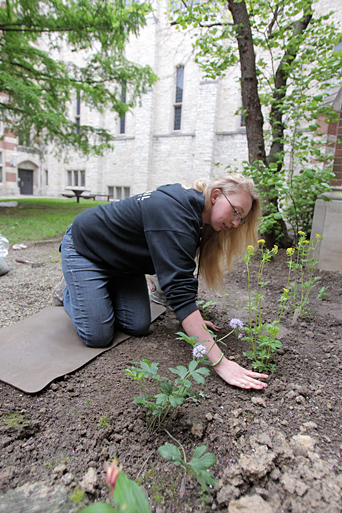
Markie Miller, a senior majoring in anthropology and German, worked on the native plant garden in University Hall’s west courtyard.
The effort was sparked when several UT anthropology students attended a public lecture on native plants and their role in a good-stewardship environmental plan, given by Dr. Eileen Metress, professor emeritus of public health.
“They were so fired up by the talk that they asked if they could do a related project here,” said Dr. Seamus Metress, professor of anthropology, and Eileen’s husband.
The Metresses proposed the idea in writing to UT President Lloyd Jacobs, who in turn sent the request to the Campus Beautification Committee, which gave it a stamp of approval and planning began.
With a $500 grant from the Student Activities Committee, the students and Eileen were able to purchase native plants indigenous to the North American prairie, of which northwest Ohio is a part.
“The plants cannot be wild-gathered,” Eileen said. “And they’re all but impossible to find.” Fortunately, she added, a local resource exists: Naturally Native Nursery near Bowling Green, the region’s only all-native-plant grower. (Read more at www.naturallynative.net.)
All the plants were utilized by Native-American tribes of the area, she explained, some for food, some for medicine, even some for clothing.
Take rattlesnake master. Its leaves resemble those of the yucca, and fibrous extracts from the plant were used to make shoes. In sheltered archaeological sites, Eileen noted, researchers have found such shoes, carbon-dated at 8,000 years. “Other parts of the plant were used to treat rattlesnake bites,” she said. Even the oversized seed head had a secondary use as a child’s rattle.
Every native plant comes with that kind of backstory, she said, making them valuable teaching tools. As an ongoing project, in fact, the garden will be used to teach a class in ethno-botany: the role of plants in human affairs.
“We’re also emphasizing how native plants can be used in local gardens to replace exotic imports and to attract bees and other pollinators,” Eileen said.
She brought up another case in point: prairie dropseed, a native grass that’s part of the garden. As plant nurseries across the country sell consumers on grasses from Asia, they neglect to mention that the exotics provide nothing for native wildlife: “Native grasses like dropseed are extremely important for pollinating creatures. Without such grasses, for instance, some butterflies have nowhere to lay their eggs. And their caterpillars don’t have the digestive enzymes to deal with the exotics.” More alarmingly, the exotics often jump to areas where wild grasses, already stressed, succumb to the invaders.
Typically, native plants provide wildlife with resources in every season, she added, with beauty for the gardener besides.
Because native plants are well adapted to the area, they’re highly drought-resistant, so garden upkeep will be minimal. No water will be needed after the first few weeks while plants are establishing themselves. Likewise, fertilizers and pesticides are strictly verboten in the sustainable garden.
Eileen gave high praise to student organizer Markie Miller, who hand-weeded one of the courtyard gravel walkways over a weekend, and Terah Koch, who like Miller is one of the project’s primary organizers.
Both Metresses agree that the students’ enthusiasm is heartening and bodes well for future discussions on the environment. “They’re involved at every part of the garden,” Seamus said. “It’s going to be a great addition to the department and the University.”